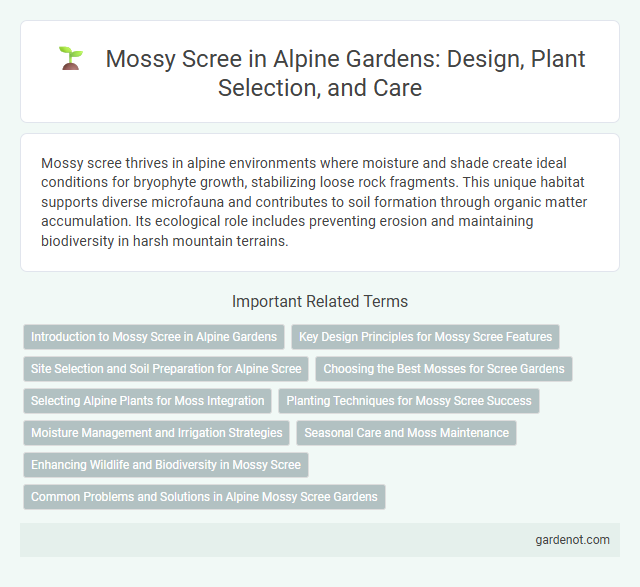Mossy scree thrives in alpine environments where moisture and shade create ideal conditions for bryophyte growth, stabilizing loose rock fragments. This unique habitat supports diverse microfauna and contributes to soil formation through organic matter accumulation. Its ecological role includes preventing erosion and maintaining biodiversity in harsh mountain terrains.
Introduction to Mossy Scree in Alpine Gardens
Mossy scree in alpine gardens creates a unique microhabitat characterized by loose, rocky debris covered with dense moss layers. This environment supports moisture retention and provides shelter for specialized plants adapted to harsh mountainous conditions. Its presence enhances biodiversity by offering niches for delicate alpine flora and small invertebrates.
Key Design Principles for Mossy Scree Features
Mossy scree features prioritize stability through careful rock placement and integration of native moss species to enhance natural erosion control. Key design principles include maximizing microhabitats by varying rock sizes and moisture retention zones, promoting biodiversity in alpine environments. Effective mossy scree design balances aesthetic appeal with ecological function, ensuring habitats support alpine flora and fauna resilience.
Site Selection and Soil Preparation for Alpine Scree
Mossy scree thrives in well-drained, acidic to neutral soils commonly found in alpine scree environments with high mineral content and low organic matter. Site selection should prioritize exposure to full sun or partial shade while ensuring adequate air circulation to prevent excessive moisture retention that can lead to root rot. Soil preparation involves creating a coarse, gritty substrate by incorporating sand, gravel, and decomposed granite to replicate natural scree conditions and enhance drainage essential for moss establishment.
Choosing the Best Mosses for Scree Gardens
Selecting the best mosses for alpine scree gardens involves identifying species adapted to harsh, rocky environments with excellent moisture retention and tolerance to temperature fluctuations. Mosses like Dicranum scoparium, Polytrichum commune, and Bryum argenteum are ideal due to their resilience and ability to stabilize loose scree substrates. Incorporating these mosses enhances soil stability and biodiversity, promoting a sustainable scree ecosystem.
Selecting Alpine Plants for Moss Integration
Selecting alpine plants for moss integration in mossy scree requires prioritizing species with high moisture retention and low nutrient demands, such as Saxifraga oppositifolia and Silene acaulis. These plants thrive in harsh scree environments by stabilizing soil and providing organic matter that supports moss growth. Incorporating cushion plants enhances the microclimate, promoting moss establishment and biodiversity within alpine scree ecosystems.
Planting Techniques for Mossy Scree Success
Planting techniques for mossy scree focus on creating stable microhabitats with optimal moisture retention and minimal soil disturbance. Using native moss species and carefully layering soil substrates enhances moss establishment and resilience against erosion. Regular misting and shade management promote healthy moss growth, ensuring long-term coverage and ecological balance in alpine scree environments.
Moisture Management and Irrigation Strategies
Mossy scree habitats benefit significantly from precise moisture management techniques that prevent waterlogging while maintaining adequate hydration for moss growth. Implementing drip irrigation systems tailored to alpine conditions ensures consistent moisture levels without disturbing the delicate substrate. These strategies optimize water use efficiency and support the ecological balance essential for moss proliferation in scree environments.
Seasonal Care and Moss Maintenance
Mossy scree requires careful seasonal care to thrive, particularly through consistent moisture retention during dry periods and protection from frost in winter. Regular removal of debris ensures optimal light exposure and prevents moss from being smothered by larger vegetation or accumulating leaf litter. To maintain healthy moss growth, avoid excessive disturbance and periodically check for signs of disease or pests that could compromise the scree's delicate ecosystem.
Enhancing Wildlife and Biodiversity in Mossy Scree
Mossy scree provides a unique microhabitat that supports diverse wildlife species, including specialized mosses, lichens, and invertebrates adapted to its moisture-rich environment. This biome acts as a natural reservoir, enhancing biodiversity by offering shelter and breeding grounds for alpine amphibians, small mammals, and insects. Conservation efforts focusing on preserving mossy scree zones contribute significantly to maintaining ecological balance and promoting species richness in alpine ecosystems.
Common Problems and Solutions in Alpine Mossy Scree Gardens
Alpine mossy scree gardens often face common problems such as poor drainage, moss overgrowth, and nutrient imbalances, which can lead to plant stress and reduced biodiversity. Effective solutions include enhancing soil drainage with coarse rock substrates, selectively thinning dense moss mats to promote air circulation, and applying balanced, slow-release fertilizers to restore nutrient levels. Regular monitoring and maintenance ensure a healthy ecosystem, supporting native alpine flora adapted to scree conditions.
Mossy scree Infographic

 gardenot.com
gardenot.com